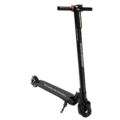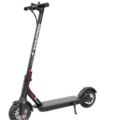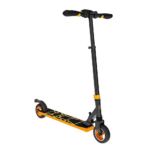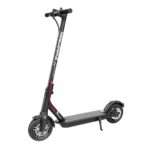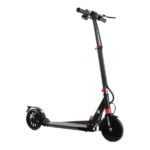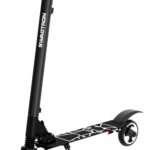- Home
- Scooters
- Electric Scooters
- Swagtron Swagger 3 Pro
Swagtron Swagger 3 Pro



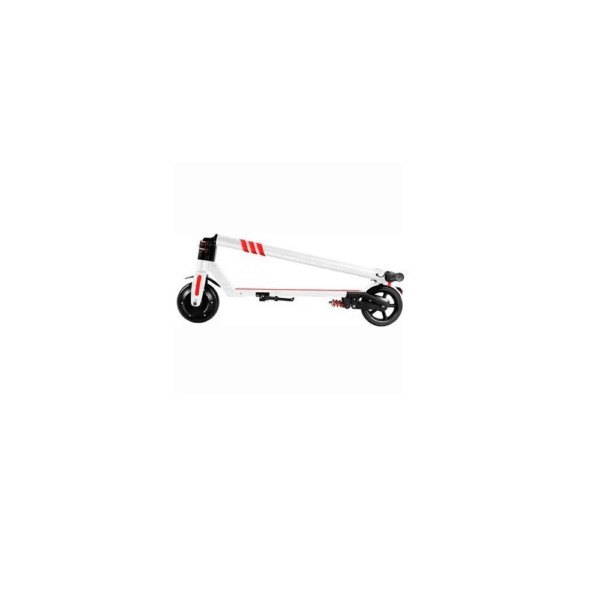
- Battery Range: 14.2 miles (22.9 km)
- Top Speed: 15.5 mph (25 km/h)
- Motor Power: 250 W
- Weight Capacity: 220 lb (100 kg)
- Charging Time: Around 3 hours
- Scooter Weight: 23.0 lb (10.5 kg)
PROS
- Compact 23 lb (10.5 kg) folding design for easy carrying
- 250 W hub motor with 15.5 mph (25 km/h) top speed
- Approx. 14.2 mi (22.9 km) range per charge for short commutes
- Dual braking with Autoguard plus rear suspension for stability
- Cruise control, backlit display and USB charging port on some variants
CONS
- Solid 6.5-inch tires and small deck limit comfort on rough roads
- Range and hill performance are modest compared with newer mid-range scooters
- No dedicated smartphone app or integrated lock
- No official water-resistance rating published
Key Takeaways
- The Swagtron Swagger 3 Pro is a folding electric scooter designed for short daily trips and flat surfaces.
- It features a 250 watt front hub motor, a maximum speed of 15.5 mph, and a lightweight aluminum frame.
- This scooter offers three speed modes and uses both electronic and foot brakes for safety.
- With a range of about 14.2 miles under ideal conditions, it’s excellent for city commuting but limited for longer distances.
- Overall, the Swagtron Swagger 3 Pro is ideal for casual riders and students looking for portable, easy-to-use transport.
Table of contents
- What Is the Swagtron Swagger 3 Pro?
- How the Swagtron Swagger 3 Pro Works
- Key Specifications
- Design & Build Quality
- Performance Fundamentals
- Battery, Range & Efficiency
- Ride Quality & Comfort
- Braking & Safety Features
- Portability & Daily Usability
- Swagtron Swagger 3 Pro vs Alternatives
- Who the Swagtron Swagger 3 Pro Is (and Isn’t) For
The Swagtron Swagger 3 Pro is a small, folding electric scooter made for short daily trips. It works best for riders who want simple transport for flat streets, not wild speed runs. You get aThe Swagtron Swagger 3 Pro is a small folding electric scooter made for short, simple trips. It works best for riders who stay mostly on flat streets and want easy storage more than big power. You get a light frame, solid tires, and a fast folding system. So it fits students, light commuters, and anyone who just wants a grab-and-go scooter.
What Is the Swagtron Swagger 3 Pro?
The Swagtron Swagger 3 Pro is a compact electric kick scooter with a 250 watt front hub motor and a 36 volt lithium-ion battery. It reaches a rated top speed of about 15.5 mph, which is roughly 25 km/h. The scooter rolls on 6.5 inch solid rubber tires and uses a small rear coil spring to soften some bumps. It supports riders up to 220 lb, or around 100 kg.
This model sits in the light commuter group. So it targets campus rides, short daily commutes, and last-mile trips from a bus or train stop. Instead of focusing on extreme hill power, it focuses on low weight and compact size. That trade makes sense if most of your riding happens on smooth paths and gentle slopes.
The battery sits inside the stem, not inside the deck. As a result, the deck stays slim and low, and the scooter looks clean. The handlebar holds the LCD display, the buttons, and the thumb throttle. Overall, the Swagtron Swagger 3 Pro feels more like a powered kick scooter than a bulky full-size e-scooter.
How the Swagtron Swagger 3 Pro Works
At the front wheel, the 250 W brushless hub motor pulls the scooter forward. First you give a small kick. Then you press the thumb throttle on the right grip, and the motor adds power in a smooth push. A controller in the stem reads the throttle and the chosen mode and sends energy from the 36 V battery to the motor.
The handlebar layout is straightforward. On the right, the thumb throttle controls speed. On the left, a lever controls the electronic front brake. In the middle, a backlit LCD shows speed, battery bars, and mode. Under the screen, small buttons let you power on, toggle the headlight, and cycle through the three speed modes. So you can learn the controls in a few minutes.
The Swagtron Swagger 3 Pro offers three speed modes. First mode keeps speed low, near a brisk walking pace. It works well for first rides or very crowded areas. Second mode matches casual bike lane speeds and feels comfortable for most city use. Third mode unlocks the full rated speed on flat ground. After a week or two, most riders pick a favorite mode and only change it for special situations.
Braking uses two systems. The electronic brake at the front wheel slows the scooter when you pull the left lever. It feels smooth and controlled at low and medium speeds. The rear fender acts as a foot brake. When you step on it, it presses against the rear wheel and adds more stopping power. So you can use the hand brake for regular slowing and add the foot brake when you need a shorter stop.
The folding system sits at the base of the stem. You flip a latch, fold the stem down toward the deck, then hook it near the rear. Next you grab the folded stem and carry the scooter as one compact piece. Once you learn the motion, the full fold or unfold takes only a few seconds.
Key Specifications
Here is a clean look at the main specifications for the Swagtron Swagger 3 Pro.
| Block | Details |
|---|---|
| General | Brand: Swagtron Model: Swagger 3 Pro (often listed as SG-3) Type: Folding electric kick scooter Max rider weight: 220 lb (100 kg) Target rider: Teens and adults |
| Performance & Power | Motor: 250 W front hub motor Rated top speed: up to about 15.5 mph (25 km/h) Practical hills: short grades around 7–10% for average riders Drive layout: single front motor Riding modes: 3 speed levels plus cruise control |
| Battery, Charging & Electrical | Battery voltage: 36 V Battery capacity: 6 Ah (about 216 Wh) Rated range: up to around 14.2 miles (about 23 km) in ideal conditions Charge time: roughly 3 hours from low charge Charger: 42 V power supply around 1.5 A Battery position: inside the stem with a built-in protection board |
| Build & Dimensions | Frame material: aluminum alloy Tire size: 6.5 in solid rubber, front and rear Unfolded size: about 41.3 x 17 x 35.4 in (1050 x 420 x 900 mm) Folded size: about 15 x 17 x 35.4 in (380 x 420 x 900 mm) Scooter weight: about 23 lb (10.5 kg) Deck: low and flat with a grippy surface and side kickstand |
| Safety & Control | Brakes: electronic front brake plus rear fender foot brake Lights: white LED headlight and rear lights Display: LCD with speed, battery, and mode Water resistance: splash-resistant for normal street use Security: key switch for basic on/off control |
| Features & Extras | Cruise control: yes, holds speed after steady throttle USB port: yes, for small devices Folding system: single hinge at the stem base Kickstand: side stand for quick parking Speed units: mph on the display, with km/h in the documentation |
| Warranty & Compliance | Warranty: limited warranty period from the maker Intended use: paved streets, sidewalks, and bike-lane style routes, where local rules allow e-scooters |
These specifications give a clear picture of what the scooter can do and how it fits daily use.
Design & Build Quality
The Swagtron Swagger 3 Pro has a clean and simple look. The aluminum frame keeps weight low and resists rust. The round stem holds the battery and wiring, so it looks slightly thicker than a classic kick scooter stem. The deck stays slim, and the whole scooter has a straightforward, no-nonsense style.
The deck surface uses a gritty, almost sandpaper-like grip. It holds your shoes in place during quick stops and over small bumps. There is enough deck length for a staggered stance, with one foot forward and one foot back. So most riders can shift weight as they brake or roll over rough patches. Very tall riders may angle their feet a bit more, yet the deck still feels usable.
The handlebar is straight and does not fold at the ends. That helps stiffness and keeps the steering feel firm. The rubber grips have simple texture and stay comfortable for short to medium rides. The central LCD sits in a basic plastic housing. It is not fancy, yet it shows speed, mode, and battery clearly enough in normal light.
At the rear, a small coil spring links the deck to the rear wheel fork. It gives a bit of suspension travel and takes the edge off harsh hits from cracks and joints. The setup is firm, so it will not turn broken streets into smooth ones. Even so, it helps enough that the scooter feels less harsh than a no-suspension solid-tire model. The spring and pivot stay visible, which makes quick checks for loose bolts very easy.
A metal kickstand mounts on the side of the deck. It folds down for parking and clicks up when you ride. It feels stable on flat ground. On uneven surfaces, you sometimes need to nudge the scooter a little to find a solid spot, which is normal for a narrow stand.
Overall, the Swagtron Swagger 3 Pro feels like a practical city tool. It skips fancy styling and focuses instead on keeping weight low and parts easy to reach.
Performance Fundamentals
On flat pavement, the Swagtron Swagger 3 Pro reaches its rated speed of about 15.5 mph for many riders under the weight limit. From a light kick start, the motor pulls smoothly. It gets you up to around 10 mph fairly quickly, then builds speed more gently until it tops out. So the scooter feels calm rather than aggressive.
The three speed modes change this feeling quite a lot. First mode keeps things slow and steady. It is great for learning, crowded paths, and tight spaces. Second mode lets you ride with casual bike traffic on flat lanes. Third mode gives you full power for open stretches and light street use. In practice, many people start in first mode. Then they move to second as they gain confidence. Third mode becomes the choice for open, familiar routes.
Hill behavior is modest, which you can expect from a 250 W motor. Short ramps and mild slopes are fine, especially near the start of a ride when the battery is full. On grades around 7–10%, the scooter slows down yet still moves if the rider weight stays under 220 lb. Long or steep hills will drag speed down a lot. At some point you may need to step off or add kicks. So this scooter really works best in flatter areas.
Stability at speed is decent for a light scooter with 6.5 inch wheels. The short wheelbase gives quick steering, so it responds fast if you twitch the bar. A relaxed stance with both hands steady on the grips keeps the ride calmer. With the folding hinge latched well and the stem bolts tight, wobble stays low in normal use. It still helps to avoid sudden sharp turns at full speed.
Battery, Range & Efficiency
The Swagtron Swagger 3 Pro uses a 36 V, 6 Ah lithium-ion pack with roughly 216 Wh of stored energy. On paper, it offers up to about 14.2 miles of range, which is close to 23 km. That figure assumes a light rider, flat ground, mild weather, and moderate speeds.
In daily riding, the real range often falls between 7 and 10 miles, or about 11 to 16 km, for a rider around 165–180 lb. City starts and stops, small hills, and full-throttle bursts all eat into that number. Cold weather can shave range down as well. On the other hand, a lighter rider who sticks to second mode and smooth paths can get closer to the rated range.
Charging is simple and quick. You plug the charger into a normal outlet, then into the port on the stem. A full charge from low battery takes around three hours. A rubber cap covers the port when you ride. It is worth checking that this cap always sits snugly to keep water and dust out. A built-in protection board inside the battery helps guard against over-charging and deep discharge.
For daily use, many riders just plug in after each commute or at the end of the day. They avoid draining the battery to zero on purpose. If you plan to store the scooter for a longer break, a half-full battery with a short top-up every few weeks works well. This kind of routine helps the pack age more slowly across many seasons.
The USB port on the stem can charge a phone or a small gadget. It is a handy backup. At the same time, that energy still comes from the main battery. So heavy phone charging will cut into your riding range. For most people, this port becomes an emergency helper more than a daily power bank.
Ride Quality & Comfort
Ride quality on the Swagtron Swagger 3 Pro reflects its small solid tires and simple suspension. On smooth pavement, the scooter feels calm, steady, and quiet. The solid rubber tires roll without any need for pressure checks or patch kits. You no longer worry about flats from glass or small nails.
Once the pavement gets rough, the limits of solid tires show up. Cracks, patched asphalt, and sharp edges send more feedback into your feet and hands. The rear coil spring helps by taking some of the sting out of those bumps. It does not erase every impact, yet it clearly cuts the worst of them. So short rough sections stay manageable if you bend your knees, keep your arms loose, and pick a clean line.
Ergonomics are decent for many heights. The bar does not adjust, yet teens and average-height adults usually find it acceptable. Tall riders might lean a bit more forward on longer rides. Grip shape is plain and practical, with enough texture to keep sweaty hands from slipping. The control buttons stay near your thumbs, so you can change modes or switch on the light without big hand movements.
Stem flex stays low as long as the hinge and bolts stay tight. Small squeaks from the rear spring or the folding latch can appear after many miles. Then a quick check with basic tools and a bit of cleaning usually quiets things down. In general, a short maintenance check every few weeks keeps ride comfort and confidence high.
Braking & Safety Features
The Swagtron Swagger 3 Pro uses a dual system for braking. The main brake is the electronic front brake, which you control with the lever on the left side of the bar. When you pull the lever, the motor slows the front wheel. At low and medium speeds, this feels smooth and easy to modulate. At higher speeds, it still feels predictable, especially if you move your weight a bit toward the rear.
The rear fender foot brake adds extra stopping force. A gentle step on the fender gives a light drag that helps on small slopes. A firm step adds more stopping power and may cause the rear to skid on loose gravel or wet ground. So the best habit is to start braking with the front lever. Then add the foot brake until the scooter slows at the rate you want.
Lighting covers the basics. A white LED headlight on the stem lights up the path ahead at city speeds. It also makes you more visible to others at dusk. Rear lights and a reflector near the back wheel help drivers and cyclists see you from behind. For heavy night riding, many owners still add a helmet light or a brighter rear light, since more visibility always helps.
The scooter offers splash resistance suited for light rain and small puddles. It is not built for deep standing water or long rides in heavy storms. Mudguards help keep spray off your legs and off the deck. After wet rides, it helps a lot to dry the scooter, clean grit off the wheels, and store it indoors. That care protects bearings, electronics, and the finish.
Local rules control where and how you can ride. Speed limits, helmet rules, and sidewalk access change from one place to another. So it makes sense to check those rules before you build a daily commute around the scooter.
Portability & Daily Usability
Portability is one of the big plus points of the Swagtron Swagger 3 Pro. At roughly 23 lb, it is light enough for most adults to carry for short stretches. Stairs in an apartment building, a station underpass, or a few steps up to a porch all stay manageable. You can pick it up with one hand, carry a bag in the other, and still feel in control.
The folding system keeps things fast. You flip the latch, fold the stem down, hook it, and then lift. The folded size of about 15 x 17 x 35.4 inches fits in many car trunks, under desks, beside a couch, or in a closet. So storage in small homes or shared offices rarely turns into a headache.
In daily use, the scooter works well as a “first and last mile” tool. You ride from home to a bus or train stop, fold the scooter, ride transit, then unfold and ride the last stretch. It also works for short errand loops around the neighborhood. The side kickstand handles quick stops at shops or cafes. For longer stops outside, a compact lock looped through the frame or stem adds some basic security.
Care and upkeep stay simple. You wipe dust and mud off the deck and stem with a damp cloth. You dry metal parts after rain. Then every few weeks, you check the hinge bolts, stem clamp, wheel nuts, and suspension hardware. That small routine keeps the scooter tight, reduces noise, and protects the folding feel. Solid tires remove the need for pumps and patch kits, which many owners appreciate.
Swagtron Swagger 3 Pro vs Alternatives
Inside the Swagtron family, the Swagger 3 Pro sits toward the lighter and simpler end. If you want a step up in range and ride feel within the same brand, you can look at the Swagtron Swagger 7. It aims at riders who want more comfort and power while still keeping a commuter focus.
There is another path too. Riders who like the compact idea but want a slightly different feature mix can check the Swagtron Swagger Pro. That model targets a similar use case, yet it gives you an option if you want to compare details like tires, deck layout, or control feel inside the same general tier.
If you look beyond Swagtron, many mid-range commuter scooters use 350–500 W motors, larger 8.5–10 inch pneumatic tires, and bigger batteries. They usually climb hills better and ride smoother over broken asphalt. On the flip side, they weigh more, often between 30 and 40 lb or even more. So they are harder to carry up stairs or onto transit.
Heavy performance or off-road scooters move even further away. They bring large motors, tall suspension setups, hydraulic brakes, and very long range. They handle steep hills and rough tracks. Yet they feel heavy, need more storage space, and often demand more skill and attention. For short city trips, they can feel like overkill.
Against that background, the Swagtron Swagger 3 Pro holds a clear place. It offers low weight, easy folding, basic suspension, and enough range for short flat commutes. Riders who want more power or more comfort can move up to bigger models. Riders who care more about small size, light carry, and simple ownership can stay happy at this level.
Who the Swagtron Swagger 3 Pro Is (and Isn’t) For
The Swagtron Swagger 3 Pro suits people with short, mostly flat routes. This includes students going between campus buildings, workers riding a couple of miles from a station, and residents using a scooter for local errands. For these riders, low weight and simple folding matter more than strong hill pull or very long range.
New riders benefit from the calm power delivery and clear controls. The three modes give a nice path from slow practice to normal commuting speeds. Cruise control helps on long straight paths by easing thumb strain. The display shows speed and battery in a simple way, so you always have a rough idea how far you can go.
The Swagtron Swagger 3 Pro is not the best fit for every rider. People close to the 220 lb limit who face long hills every day will want more motor power and more capacity in the battery. Riders who often cover more than 8–10 miles in one go, without a chance to charge, will feel safer with a larger pack. Those who live with broken, cracked streets all day will likely prefer bigger pneumatic tires and more advanced suspension.
Once you understand those limits, the scooter becomes easier to judge. The Swagtron Swagger 3 Pro gives you a compact frame, a modest but usable motor, solid tires, and a quick folding latch. With basic checks on bolts and smart charging habits, it can serve as a light, handy partner for short city rides and daily errands for quite a long time.
Specifications
General
| Model The Model specifies the exact version or name of the scooter. It helps identify its unique design, features, and specifications within the manufacturer’s product line. Knowing the model makes it easier to compare options, find compatible accessories, or look up support information. | Swagger 3 Pro |
| Brand The Brand identifies the manufacturer or company that designs and produces the scooter. A trusted brand is a sign of quality, reliability, and good customer support. Well-known brands often have higher standards for safety, performance, and after-sales service, giving you more confidence in your purchase. | Swagtron |
| Release Date The Release Date indicates when the scooter model was officially launched on the market. This helps you know how current the design, technology, and features are. A newer release date often means updated components, improved performance, and the latest safety or smart features. | 18 November 2025 |
| Recommended Age Recommended Age indicates the minimum age range that the scooter is designed for, based on safety, size, and ease of use. Following the recommended age helps ensure that riders can handle the scooter’s speed, weight, and controls comfortably and safely. Always check local laws and use protective gear, especially for younger riders. | +16 |
Performance & Power
| Motor Power (Wattage) What it means: The motor power, measured in watts (W), shows how strong the scooter’s electric motor is. Why it matters: Higher wattage usually means better acceleration, more torque, and improved performance on hills or rough terrain. For example, a 250W motor is good for flat city roads and light riders, while a 500W or 1000W motor provides more power for faster speeds or climbing steep inclines. | 250 W front hub motor |
| Top Speed The Top Speed indicates the maximum speed that the scooter can reach under optimal conditions. It’s usually measured on level ground with a fully charged battery and an average rider weight. A higher top speed allows you to travel longer distances faster, but always ensure you ride within legal speed limits and your personal comfort zone for safety. | 15.5 mph (25 km/h) |
| Battery Capacity Battery Capacity refers to the total amount of energy the scooter’s battery can store, usually measured in ampere-hours (Ah) or watt-hours (Wh). A higher battery capacity means you can ride longer distances on a single charge, reducing the need for frequent recharging. Keep in mind that actual range can vary depending on rider weight, terrain, speed, and weather conditions. | 36 V 6.0 Ah (216 Wh) lithium-ion battery |
| Estimated Range per Charge The Estimated Range per Charge indicates the average distance the scooter can travel on a single full battery charge. This range is calculated under optimal conditions, such as flat terrain, moderate speed, and average rider weight. Real-world range may vary depending on riding style, terrain, weather, and load. A longer range means fewer recharges and greater freedom for longer trips. | 14.2 miles (22.9 km) per charge in ideal conditions |
| Hill Climb Ability Hill Climb Ability describes the maximum incline or slope that the scooter can handle while maintaining stable performance. It’s typically expressed as a percentage or in degrees. A higher hill climb rating means the scooter can tackle steeper hills without losing too much speed or power. Actual climbing performance may vary based on rider weight, battery charge, and terrain conditions. | Claimed 25° hill-climbing capability |
| Drive System The Drive System refers to how power from the motor is delivered to the wheels. Electric scooters typically use either a hub motor (directly integrated into the wheel) or a chain/belt drive system. A high-quality drive system ensures smooth acceleration, efficient power transfer, and low maintenance. The choice of drive system affects performance, noise level, and overall ride experience. | Front hub (FWD) |
Charging & Electrical
| Charging Time Charging Time indicates how long it takes to fully recharge the scooter’s battery from empty to 100% using the standard charger provided. Faster charging means less downtime and more time on the road. Actual charging time may vary slightly depending on battery capacity, charger output, and environmental conditions. | Roughly 3 hours with included charger |
| Battery Type Battery Type refers to the specific technology used in the scooter’s battery, which affects performance, lifespan, weight, and charging time. Most modern electric scooters use high-quality lithium-ion (Li-ion) batteries because they offer a good balance of energy density, durability, and low maintenance. A reliable battery type ensures consistent power delivery and longer riding ranges. | Lithium-ion pack with Smart Battery Management System |
| Removable Battery A Removable Battery means the battery pack can be easily detached from the scooter for convenient charging and replacement. This feature allows you to charge the battery separately, swap it with a spare for extended range, or securely store it indoors in extreme weather. Removable batteries add flexibility and make it easier to keep your scooter powered up wherever you are. | Non-removable internal battery (fixed pack) |
| Regenerative Braking Regenerative Braking is an energy-saving feature that converts some of the energy normally lost during braking back into battery power. When you slow down or brake, the motor works in reverse to generate electricity, which helps extend the scooter’s range and improves overall efficiency. This system also reduces wear on traditional brake components, leading to lower maintenance over time. | Not specified |
| Lighting Lighting refers to the built-in front and rear lights that enhance visibility and safety when riding in low-light conditions or at night. Good lighting helps you see the road ahead and ensures that other road users can see you. Many scooters include LED headlights, taillights, and sometimes brake lights or side reflectors for added safety and compliance with local traffic regulations. | LED headlight, rear lighting and reflectors depending on region |
Build & Dimensions
| Scooter Weight Scooter Weight refers to the total weight of the scooter when fully assembled, including the battery. This affects how easy it is to carry, lift, and store the scooter when not in use. A lighter scooter is more portable and convenient for commuting, especially if you need to carry it upstairs or onto public transport. Keep in mind that a sturdy frame and quality components may add to the weight but also contribute to better durability and ride stability. | 23.0 lb (10.5 kg) |
| Maximum Rider Weight Maximum Rider Weight indicates the highest rider weight that the scooter is designed to safely support while maintaining optimal performance and stability. Staying within this limit helps ensure reliable acceleration, braking, and climbing ability, and it protects the frame, suspension, and motor from excessive strain. Exceeding the recommended limit may reduce performance and increase wear on components. | 220 lb (100 kg) |
| Deck Size Deck Size refers to the dimensions of the scooter’s standing platform. A wider and longer deck provides more foot space, allowing you to stand comfortably and adjust your stance while riding. A well-sized deck improves balance and stability, especially on longer rides or at higher speeds. Compact decks, on the other hand, help keep the scooter lightweight and portable. | Folding aluminum commuter frame with compact deck |
| Handlebar Height Handlebar Height refers to the distance from the deck to the handlebars, which affects your riding posture and comfort. An appropriate handlebar height helps you maintain good balance, reduces strain on your back and arms, and makes steering more comfortable. Some scooters have adjustable handlebars to fit riders of different heights, while others have a fixed height for a streamlined design. | Fixed-height handlebar |
| Folding Mechanism The Folding Mechanism describes how easily and securely the scooter can be folded for carrying and storage. A well-designed folding system lets you quickly collapse the scooter into a compact size, making it convenient to transport on public transit, store under a desk, or fit into a car trunk. Look for sturdy latches and safety locks to ensure the scooter stays firmly in place when folded or unfolded. | Quick-fold stem hinge with locking latch |
| Dimensions Folded Dimensions indicate the size of the scooter when it’s fully folded. This measurement shows how much space the scooter will take up when stored or carried, making it easier to check if it will fit in your car trunk, under a desk, or in a closet. Compact folded dimensions are ideal for commuters who need to bring their scooter on public transport or store it in tight spaces. | Unfolded: 41.3 × 17.0 × 35.4 in (105 × 43 × 90 cm); Folded: 15.0 × 17.0 × 35.4 in (38 × 43 × 90 cm) |
| Material Material refers to the primary construction materials used for the scooter’s frame and key components. High-quality materials like aircraft-grade aluminum, reinforced steel, or durable composites provide strength, stability, and a lighter overall weight. A sturdy material ensures the scooter can handle daily wear and tear while maintaining safety and performance. | Aluminum alloy |
Safety & Control
| Brake Type(s) Brake Type(s) describe the braking systems the scooter uses to help you slow down or stop safely. Common brake types include mechanical brakes (like drum or disc brakes), electronic brakes, and foot brakes. Many scooters combine multiple braking systems for added safety and shorter stopping distances. The type and quality of brakes affect your control, especially when riding at higher speeds or on slopes. | Front electronic brake with Autoguard + rear heel brake |
| Suspension Suspension refers to the system that absorbs shocks and vibrations while riding, providing a smoother and more comfortable ride over uneven or rough surfaces. Scooters may have front suspension, rear suspension, or dual suspension for better shock absorption and stability. Good suspension helps reduce rider fatigue and improves control, especially when riding on bumpy roads or off-road paths. | Rear suspension |
| Tire Type Tire Type refers to the kind of tires the scooter uses, which directly affects ride comfort, traction, and maintenance. Common types include solid (airless) tires, pneumatic (air-filled) tires, or hybrid options. Pneumatic tires offer better shock absorption and a smoother ride on rough surfaces, while solid tires are puncture-proof and require less upkeep. The right tire type helps ensure safe handling and a comfortable ride in different conditions. | 6.5-inch solid rubber tires |
| Tire Size Tire Size indicates the diameter and width of the scooter’s tires, which affect ride comfort, stability, and how well the scooter handles different terrains. Larger tires generally offer better shock absorption and a smoother ride over bumps and rough surfaces, while smaller tires keep the scooter lighter and more portable. Choosing the right tire size helps ensure a balance between agility and comfort. | 6.5-inch |
| Kickstand The Kickstand is a built-in stand that allows you to park your scooter upright when it’s not in use. A sturdy kickstand keeps the scooter stable and prevents it from tipping over, protecting it from scratches and damage. It also makes storing and accessing your scooter more convenient, whether you’re at home, work, or on the go. | Side kickstand |
| Water Resistance Rating Water Resistance Rating indicates how well the scooter is protected against water and moisture, usually shown as an IP (Ingress Protection) rating. This rating helps you understand whether the scooter can handle light rain, splashes, or wet roads without damage. While most scooters are not fully waterproof, a good water resistance rating adds peace of mind when riding in changing weather conditions. Always avoid deep puddles or submerging the scooter to protect its electrical components. | Not specified |
Features & Extras
| Display/Console The Display (or Console) shows important real-time information about your ride, helping you monitor your scooter’s status at a glance. Typical displays show speed, battery level, distance traveled, and riding mode. Some models also include additional features like Bluetooth connectivity, app integration, or backlighting for better visibility at night. A clear and easy-to-read display enhances safety and convenience on every trip. | Backlit LCD display with speed, battery level, mode and cruise status |
| Ride Modes Ride Modes refer to the different speed and power settings you can choose to match your riding style or road conditions. Common modes include eco for maximum range and energy efficiency, standard for everyday balance, and sport or turbo for higher speed and stronger acceleration. Switching between ride modes allows you to customize performance, conserve battery, and ride safely in various environments. | Three riding modes with user-selectable speed limits |
| Smart App Connectivity Smart App Connectivity lets you pair your scooter with a dedicated mobile app via Bluetooth. Using the app, you can monitor real-time ride stats like speed, battery level, and range, adjust settings such as ride modes or cruise control, lock the scooter for added security, and sometimes receive firmware updates. This feature adds convenience and allows you to personalize your riding experience right from your smartphone. | No dedicated mobile app; controls and info on handlebar display |
| Anti-Theft System The Anti-Theft System helps protect your scooter from unauthorized use or theft. This feature can include built-in alarms, electronic motor locks, GPS tracking, or remote locking through a mobile app. A good anti-theft system provides peace of mind when parking your scooter in public spaces, adding an extra layer of security to safeguard your investment. | Keyless start; use external lock for security |
| Cruise Control Cruise Control allows you to maintain a steady speed without continuously holding the throttle. This feature makes longer rides more comfortable by reducing hand fatigue and providing a smoother, more relaxed riding experience — especially on flat, open roads or bike lanes. For safety, cruise control can usually be easily activated or deactivated while riding. | Yes (cruise control via handlebar button) |
| Accessories Included Accessories Included lists the additional items that come with the scooter to enhance your riding experience and convenience. Common accessories may include a charger, kickstand, bell, lights, phone holder, or carrying strap. These extras add value by making your scooter safer, easier to use, and ready to ride straight out of the box. | Scooter, charger, user manual, basic tools |
Warranty & Compliance
| Warranty Period The Warranty Period indicates how long the manufacturer guarantees the scooter against defects in materials and workmanship under normal use. A good warranty provides peace of mind, showing the brand’s confidence in its product quality. Always check what parts are covered, such as the frame, battery, and motor, and follow the maintenance guidelines to keep your warranty valid. | 12-month limited warranty (region-dependent) |
| Certifications Certifications confirm that the scooter meets specific safety, quality, and environmental standards set by recognized organizations or regulatory bodies. Common certifications may include CE, RoHS, UL, or other local compliance marks, depending on your region. These certifications ensure that the scooter is manufactured to high standards and is safe and legal to use in your country. | UL-certified battery; general consumer product safety compliance (region-dependent) |


